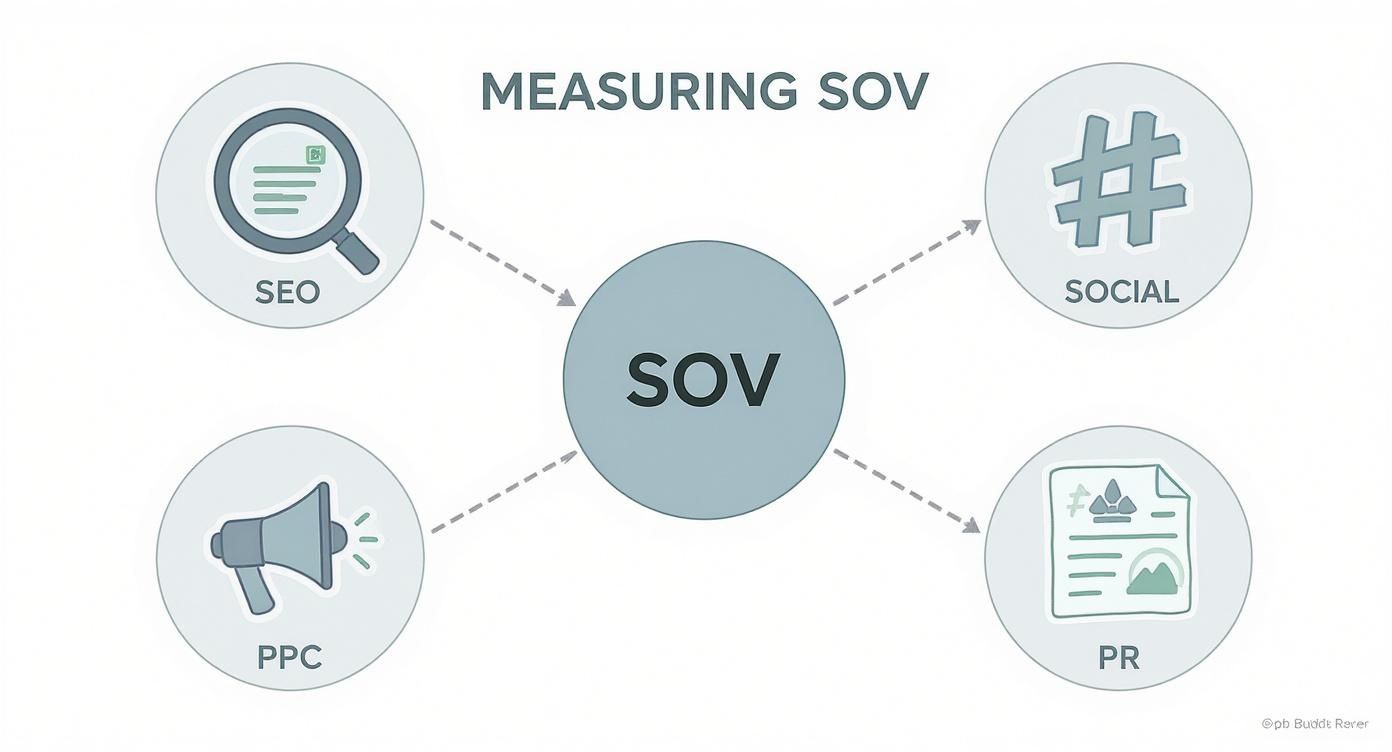A Guide to Share of Voice Marketing
Share of voice is your slice of the market conversation. It’s a way to measure your brand’s visibility against your competitors. Think of it this way: a bigger share means more people are hearing about you, not them.
What Share of Voice Actually Means for Your Brand

Imagine your entire market is a packed stadium. Every brand is shouting, trying to get the crowd’s attention. Your Share of Voice (SOV) is just a metric that tells you how loud your brand is compared to everyone else. It’s the percentage of the conversation your brand actually owns.
Not too long ago, SOV was a simple advertising metric. You'd just compare TV ad spots or print placements. If your rival ran 100 commercials and you only ran 50, their share of voice was double yours. Easy. The concept is still the same, but today's "stadium" is a whole lot bigger and way more digital.
The Evolution from Ads to Clicks
Modern share of voice marketing is so much more than paid ads. It now covers all the digital channels where your audience is actually spending their time. This shift is a big deal because customers don’t follow a straight line to buying something anymore; their journey is scattered across search engines, social media, and online reviews.
That means you need a much broader view to track your visibility. A complete SOV analysis today has to include:
- Organic Search (SEO): How often do you show up on the first page of Google for key search terms compared to your competitors?
- Social Media: How many brand mentions, hashtags, and social conversations are about you versus the total industry chatter?
- Paid Media (PPC): What’s your ad impression share on platforms like Google Ads and Meta?
- Public Relations: How many times is your brand mentioned in online articles, blogs, and news sites?
Why This Metric Matters for Growth
Keeping an eye on your SOV is more than just a way to see how you stack up against the competition. It’s a direct signal of your brand's health and potential for growth. A consistently high share of voice almost always leads to better brand recognition and trust. When people see your brand more often and in more places, you become their go-to choice.
Share of voice is a critical marketing metric representing a brand's presence in its market relative to competitors. Monitoring SOV across channels like social media, SEO, and paid advertising is essential because consumer journeys are so fragmented. For instance, if your brand has 500 Instagram mentions out of a total of 10,000 in your industry, your Instagram SOV is 5%. Get more insights on how to measure your visibility on Talkwalker.com.
Ultimately, tracking this helps you pinpoint where your competitors are dominating the conversation and where you can find new opportunities. By working to increase your presence on the channels that matter most, you can directly build brand awareness, establish your authority, and set the stage for real, sustainable growth in your market.
The Proven Link Between Visibility and Market Share

It just feels right, doesn’t it? The more people see your brand, the more they’ll buy. This isn't just a marketing hunch; it's a fundamental principle backed by decades of solid research. There’s a direct and powerful line connecting a brand's visibility to its slice of the market.
Think of it as a snowball effect. A small ball rolling downhill gathers more snow, getting bigger and faster as it goes. In the same way, consistently investing in your visibility creates a self-fuelling cycle of growth, turning smaller players into market leaders over time.
This relationship is perfectly captured by a concept called Extra Share of Voice (ESOV). Simply put, ESOV is the gap between your Share of Voice and your current Share of Market. When your SOV is bigger than your market share, you have a positive ESOV—and that’s one of the strongest predictors of future growth you can find.
The Science Behind ESOV
This isn't just marketing theory; it's a number you can actually work with. Study after study has shown that brands that set their SOV above their market share almost always grow.
One of the most famous studies found that for every 10% of positive ESOV a brand holds onto, it can expect to grow its market share by an average of 0.5% each year. You can dig into these findings over at Nielsen.com.
So, if you currently have a 10% market share, aiming for a 20% Share of Voice gives you an ESOV of +10 points. That's not just a vanity metric; it’s a clear roadmap for growth. It’s how you switch from playing defense to playing offense.
By investing in visibility beyond your current standing, you're not just maintaining your position; you're actively creating the conditions for market expansion. This makes share of voice marketing a proactive strategy for ambitious brands.
Real-World Application and Nuances
Of course, this isn't a magical law that works the same way every time. How well ESOV translates into growth depends on a few things, like your industry, your brand's size, and honestly, how good your ads are.
- Market Leaders vs. Challengers: Big, established brands often need less ESOV to hold their ground. But if you're a smaller challenger, you’ll probably need a much higher ESOV to make a real dent.
- Creative Quality: A huge SOV won't do much if your creative is boring or ineffective. The quality of your message is just as important as how loud you're shouting it.
- Industry Dynamics: In crowded, fast-moving markets, you might need a higher ESOV just to keep up with competitors who are also spending big to get noticed.
Understanding these nuances is key to setting goals that make sense. It’s why you can’t just set your budget and forget it. Continuously monitoring your brand’s presence and how people feel about it is non-negotiable. For a fuller picture, you can explore comprehensive brand health tracking, which adds crucial context to your SOV numbers.
This broader view helps you see not just how loud you are, but if anyone is actually listening. At the end of the day, the link is undeniable: smart, consistent visibility is what paves the road to a bigger market share.
How to Measure Share of Voice in the Digital Age
Knowing that share of voice can drive market share is one thing, but actually measuring it is a whole different ball game. The old days of just tracking ad spend are long gone. Today, the "market conversation" is scattered across dozens of digital channels, transforming SOV from a simple metric into a complex measure of your brand's entire online footprint.
To get a real sense of where you stand, you can’t just look at one channel. You have to piece together your performance across all the key arenas where your customers are hanging out. The basic formula is pretty consistent, but the specific metrics you track will change from one platform to the next.
Share of Voice Formula: (Your Brand's Metric / Total Market Metric) x 100 = Your SOV %
This simple equation is your starting point. Let’s break down how to apply it to the channels that really matter.
Measuring SEO Share of Voice
For most businesses, organic search visibility is the bedrock of their digital presence. In the world of SEO, share of voice measures how often your brand shows up in search results for your target keywords compared to your competitors.
Think of the first page of Google as prime digital real estate. Your SEO share of voice tells you exactly how much of that property you own. The key metrics to keep an eye on are:
- Keyword Rankings: How many of your most important keywords are ranking on the first page? You can track this for your own brand and stack it up against a defined list of competitors.
- Organic Impressions: This is the number of times your website is shown in search results. Most good SEO tools provide this data, making it easy to compare your impression volume against your rivals.
- Organic Clicks/Traffic: Impressions tell you about visibility, but clicks tell you about engagement. A high share of clicks means you’re not just showing up—you’re actually convincing people to visit your site.
Tracking these numbers helps you see if your content strategy is successfully capturing more of the search conversation in your industry.
Tracking Social Media Share of Voice
Social media is where the public conversation happens in real-time. It’s where customers praise, complain, and ask questions, making it an essential channel for SOV analysis. Here, you’re measuring your brand's slice of all that social chatter.
The most common metrics to follow include:
- Brand Mentions: The raw number of times your brand is mentioned (with or without a tag) versus your competitors.
- Specific Hashtags: Track how often your branded hashtags are used compared to competitor hashtags or broader industry ones. For example, if your hashtag is used 100 times in a market where the total relevant hashtag usage is 1,000, your SOV is 10%.
- Reach and Engagement: Look at the total reach of posts that mention your brand and the engagement they get (likes, comments, shares).
Social listening tools are a must-have here. They can track these metrics at scale and even analyze the sentiment behind the mentions, telling you not just how much people are talking, but how they feel.
Calculating PPC Share of Voice
When it comes to paid advertising, share of voice is much more direct and often easier to measure. Pay-per-click (PPC) platforms like Google Ads give you a specific metric for this: Impression Share.
Impression Share is simply the percentage of impressions your ads received compared to the total number of impressions they were eligible to get.
For instance, if your ads were eligible to be shown 1,000 times for a certain keyword but only appeared 700 times, your Impression Share is 70%. That means you lost out on 30% of potential visibility, either to competitors or because of a low ad rank.
This metric provides a clear benchmark for your paid visibility. If your Impression Share is low on your most important keywords, it's a sign that competitors are outbidding you or have a better Quality Score. It might be time to bump up your budget or optimize your campaigns.
Monitoring Public Relations and Media Mentions
Finally, don’t forget the power of digital PR. Mentions in online news articles, industry blogs, and other publications add serious weight to your brand’s authority and visibility.
To measure this, you can track the total volume of media mentions your brand gets compared to competitors over a set period. Setting up alerts or using media monitoring tools makes it easy to count every article, review, or press release that features your brand name.
Share of Voice Measurement Across Different Channels
To help you get a handle on this, we've put together a table that breaks down the key metrics and calculation methods for each major channel. Think of this as your cheat sheet for measuring SOV where it counts.
| Channel | Primary Metric | How to Calculate |
|---|---|---|
| SEO | Organic Impressions or Clicks | (Your Impressions / Total Market Impressions) x 100 |
| Social Media | Brand Mentions or Hashtag Use | (Your Mentions / Total Relevant Mentions) x 100 |
| PPC | Impression Share | (Actual Impressions / Eligible Impressions) x 100 |
| Digital PR | Volume of Media Mentions | (Your Media Mentions / Total Competitor Mentions) x 100 |
Pulling all these different data points together gives you a complete, 360-degree view of your market presence. Each channel offers a unique piece of the puzzle, and it's only by looking at them together that you can get an accurate sense of your true share of voice.
If you’re ready for a more detailed walkthrough, our guide offers step-by-step instructions to help you calculate your share of voice effectively.
Essential Tools for Tracking Your Competitors
Trying to track your share of voice manually is like trying to count every car on the highway during rush hour. It’s overwhelming, wildly inefficient, and you'll never get an accurate picture. To really monitor your rivals and understand their place in the market, you need dedicated competitor analysis tools. These platforms do the heavy lifting, automating data collection so you can get the clarity you need to make smart moves.
The right tools turn mountains of raw data into a real strategic advantage. Most businesses find that a combination of tools works best, since different platforms specialize in different channels. This is how you get a true 360-degree view of your market.
This concept map gives a great visual of how share of voice breaks down across the four main digital marketing channels.

As you can see, each channel—SEO, social, PPC, and PR—plays a distinct role in shaping your overall presence and visibility in the market.
Tools for Social Listening
Think of social listening tools as your ears on the ground. They pick up on the real-time buzz happening around your brand and your competitors online. These platforms go way beyond just counting mentions; they analyze sentiment, pinpoint key conversation themes, and even track hashtag performance. This is how you understand the quality of the conversation, not just the quantity.
Leaders in this space, like Talkwalker and Brandwatch, are fantastic at a few key things:
- Tracking Brand Mentions: They scan conversations across all the major social networks, blogs, and forums to see who’s talking about you versus your competition.
- Sentiment Analysis: They can automatically tell if mentions are positive, negative, or neutral, giving you a quick read on public perception.
- Identifying Trends: They help you spot emerging topics in your industry, so you can jump into relevant conversations before they hit their peak.
If you’re trying to figure out which platform is the right fit, our detailed social media listening tools comparison offers some great insights to help you choose.
Platforms for SEO Visibility
In the constant battle for the top spots on Google, SEO platforms are your best friend. Your share of voice here is all about how visible you are on search engine results pages (SERPs) for the keywords your customers are using. Tools like SEMrush and Ahrefs give you the critical data you need to measure where you stand and how to move up.
These platforms help you answer the big questions:
- How many keywords do we rank for compared to our top three competitors?
- What’s our estimated organic traffic versus theirs?
- Where are the "keyword gaps"—those valuable terms our competitors rank for that we're completely missing?
By digging into this data, you can spot weaknesses in your competitors' SEO strategies and find clear opportunities to steal some of their organic traffic.
Tracking competitor keyword rankings and backlink profiles lets you reverse-engineer what's working for them (and what isn't). This intelligence is the foundation of an effective share of voice marketing strategy for organic search, turning simple analysis into a real growth plan.
Native Ad Platform Reports
When it comes to paid advertising, your best source of data is often the ad platforms themselves. Both Google Ads and Meta Ads have built-in reporting that directly measures how visible your ads are compared to the competition.
The metric you absolutely have to watch here is Impression Share. It tells you the percentage of time your ads were shown out of all the times they could have been shown. If your impression share is low, it's a clear sign that your competitors are outbidding you or have a higher Ad Rank for your most important keywords.
For anyone running paid campaigns, checking these native reports regularly is non-negotiable. It's the most direct way to see how much of the paid conversation you truly own and where you might need to adjust your budget or targeting to stay in the game.
Actionable Strategies to Increase Your Share of Voice

Knowing how to measure your share of voice is a great start, but the real work begins when you’re ready to grow it. Bumping up your brand’s presence isn’t about making random noise; it's about following a deliberate playbook of proven tactics. It’s about making smart, sustainable moves that build market dominance over the long haul.
Real growth comes from hitting multiple channels at once. You can’t just lean on one area to do all the heavy lifting for your brand. Instead, the magic happens when you combine sharp SEO, authoritative content, and strategic social media to create a powerful echo chamber for your brand.
Dominate Search with Smart SEO
Winning in search is simple in theory: be the most helpful answer wherever your audience is looking. It all starts with figuring out where your competitors are dropping the ball and then capitalizing on those gaps.
One of the best ways to do this is with a keyword gap analysis. This process helps you uncover valuable keywords that your competitors are ranking for, but you aren't. Targeting these terms is a direct line to siphoning off some of their organic traffic and claiming more of the search conversation for yourself.
You’ll also want to focus on building a strong backlink profile. Every high-quality link from a respected site is like a vote of confidence in Google’s eyes. Go after guest posting opportunities, create original research that’s impossible not to link to, and use digital PR to earn mentions that boost your authority and visibility.
Become a Go-To Resource with Pillar Content
If you really want to own a topic in your industry, you need to create content that’s simply impossible to ignore. This is where pillar pages and topic clusters come into play. A pillar page is a massive, in-depth guide on a core topic, while the cluster content dives deeper into related subtopics, with everything linking back to that main pillar.
This structure tells search engines that you're the authority on the subject. For instance, a software company might build a pillar page on "Project Management for Small Teams" and then surround it with cluster posts on specific methodologies, tools, and tips.
Publishing original data is another powerful move. Running your own surveys or analyzing unique datasets can make your brand the primary source for fresh insights. When other blogs and publications cite your research, you build valuable backlinks and cement your brand as a thought leader.
Amplify Your Voice on Social Media
Social media is a constant battle for attention, and winning your share means doing more than just posting updates. It's about strategically jumping into the conversations that actually matter to your audience. Keep an eye on trending topics and relevant hashtags to find your opening to add value, not just to plug your product.
Social media is still the main arena for measuring Share of Voice, since about 65.7% of the world's population uses it. This massive audience makes platforms like X (formerly Twitter) and LinkedIn the primary battlegrounds for owning conversations. Tracking mentions, hashtags, and engagement gives you a real-time pulse on what customers are thinking, which directly affects loyalty and sales.
Working with the right influencers can also give your reach a massive boost. Look for creators whose audience is a perfect match for your ideal customer. A single mention from a voice they trust can do more for your brand's credibility than a dozen of your own posts.
For brands targeting professionals, being effective on LinkedIn is non-negotiable. Learning the ins and outs of scheduling posts on LinkedIn Company Pages helps you maintain a steady drumbeat of content and keep your brand top-of-mind.
When you blend these SEO, content, and social strategies, you create a powerful, self-reinforcing loop. Stronger content boosts your SEO, which drives more traffic. Meanwhile, social media amplifies your message and builds a community around your brand—all working together to steadily grow your share of voice.
Your Share of Voice Questions, Answered
Even when you've got the basics down, a few practical questions always pop up when it comes to share of voice. Let's tackle some of the most common ones so you can move from theory to action.
How Often Should I Measure SOV?
The right answer really depends on how fast your industry moves. If you're in a fast-paced space like consumer electronics or seasonal retail, things change in a flash. You might need to check your SOV weekly, or even daily, just to keep up with competitor campaigns and new product launches.
But for more traditional B2B industries with longer, more considered sales cycles, a monthly or quarterly check-in usually does the trick. The key is to match your measurement cadence to the rhythm of the conversation in your market.
What Is a Good Share of Voice Target?
This is a classic question, but there's no magic number that works for everyone. Instead of chasing an arbitrary percentage, your real goal should be to achieve an Extra Share of Voice (ESOV). That just means your share of voice is higher than your actual market share.
For instance, if you currently own 8% of the market, a solid starting target would be an SOV somewhere in the 12-15% range.
A positive ESOV is one of the most reliable predictors of market share growth. Your target isn't just a random number; it's a strategic move designed to outrun your current position and drive future growth. Stop focusing on a magic metric and start focusing on outpacing your market share.
How Can a Small Business Compete for SOV?
Look, smaller businesses can't go toe-to-toe with the massive ad budgets of the big players. But you can still win at SOV by being smarter and more focused. Don't try to be the loudest voice in the whole stadium. Instead, find a smaller, less crowded section and completely own it.
Here are a few ways to do that:
- Dominate a Niche: Pour all your energy into a specific, underserved keyword group or a tight-knit community on social media. Become the name everyone knows in that smaller conversation.
- Own a Specific Channel: If all your competitors are battling it out on Google Ads, maybe you can become the dominant voice on LinkedIn or a specific Reddit community where there’s less noise.
- Be More Agile: Use your size as a superpower. Jump on new trends and conversations way faster than a big, slow-moving corporation ever could.
By being selective and strategic, even a small brand can carve out a dominant share of voice in the conversations that actually drive growth.
Ready to stop guessing and start winning the conversations that matter? Intently uses advanced AI to monitor platforms like Reddit and X, surfacing high-intent leads and competitor insights in real-time. Discover how our targeted social listening can give you a strategic edge. Learn more at Intently.ai.
